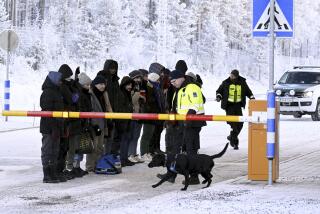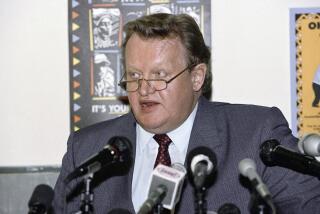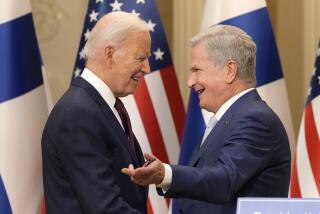Finland, 1st Reagan Stop: Reindeer, Saunas--and Neutrality
HELSINKI, Finland — When President Reagan stops in Finland en route to the summit meeting in Moscow, he can expect a warm welcome in this normally cold country that shares a border with the Soviet Union.
Reagan, who is to arrive Thursday and spend four days here in Europe’s northernmost capital, will meet with President Mauno Koivisto and Premier Harri Holkeri, who have had considerable direct contact with Soviet leaders. He is also scheduled to deliver a major speech.
The President may choose to devote a moment or two to Finland’s national pastime, the sauna, and he may dine on the specialty of the local cuisine, reindeer steak.
In any event, he will find a free-enterprise economy flourishing in an independent country that makes no apologies for the neutralism it has pursued through all the years of the East-West conflict.
“There has been an important role for Finland in building bridges between East and West,” Jukka Valtasaari, a senior official in Finland’s Foreign Ministry, said recently. “I think people have come to realize that being neutral is not necessarily all bad. We are really looking forward to the President’s visit, and we will be flattered by his presence.”
Suggestion of a Sellout
The Finns hope the President, and perhaps some of his conservative advisers, will change their minds about the catchword Finlandization , which for years has had a negative connotation.
The term is often applied to a nation whose leaders are intimidated by the Soviet Union and whose policies are dominated by the Kremlin. Sometimes it suggests that a nation’s leaders are selling out to the Soviets.
“The term is misused,” Valtasaari said. “Finlandization has nothing to do with Finland. It is used by political analysts thousands of miles away. Fortunately, it seems to be going out of fashion.”
Olli Kivinen, foreign editor of the daily newspaper Helsingin Sanomat, put it this way: “We have been able to show our Western friends the benefits of our neutralism. It is no longer thought to be immoral.”
Finns insist that they have managed to maintain their independence despite their proximity to the Soviet Union, and despite the fact that in World War II they lost to the Soviets.
Today, Finland’s relations with the Soviet Union are amicable, as they largely have been over the years. About 15% of Finland’s trade is carried on with the Soviet Union. They use a barter system, involving for the most part Soviet oil in exchange for Finland’s high-technology products.
“One reason we have got along with the Russians,” Kivinen said, “is that they never occupied us militarily, though they did, of course, get large chunks of our territory after the war. We don’t have the same hard feelings about occupation that other countries have.”
Finland was once an autonomous Russian grand duchy but achieved independence in 1917. Between the world wars, Finland was held up to American students as the only European nation that “paid its war debts” to the United States.
In 1939, when the Soviets attacked Finland in the so-called Winter War, American sentiment rallied to the Finnish cause. The Finns held the Russians off for months but were finally defeated. The peace settlement of 1940 ceded lands in southeastern Finland to Moscow.
In 1941, when Germany attacked the Soviet Union, the Finns joined in, although not formally as Germany’s allies, and quickly regained their lost territory. But by 1944 they had again been pushed back, and they sued for peace.
This time the Finns lost considerable territory along their eastern border, including their second-largest city, Viipuri, which the Soviets now call Vyborg.
“I think the reason they didn’t occupy us,” a government official said, “was that the Russians wanted a buffer state. If they had moved into Finland permanently, Sweden probably would have joined the Western military alliance.”
At the end of the war, much of Finland was in ruins, and there were 400,000 refugees. But by dint of hard work and creativity in design, ranging from glassware to icebreaker ships, Finland has brought off a near-miracle. It has developed into a comfortable welfare state, with one of the world’s highest standards of living.
In 1952, as if to celebrate its recovery, Finland put on the Olympic Games in Helsinki and established the city as a world-class capital.
In 1975, the Helsinki accords were signed here by the 35 governments that took part in the Conference on Security and Cooperation in Europe. The ceremony took place in Finlandia Hall, the white marble edifice designed by the master builder Alvar Aalto. Gerald R. Ford, the last American President to visit Finland, signed for the United States.
Helsinki is widely regarded as a gem of a capital, with handsome buildings, public parks, water always nearby and a fine collection of public buildings clustered around Senate Square and the Lutheran Cathedral, along with a string of elegant shops along the wide boulevard called the Esplanade.
Another major street is the Mannerheimintie, named for military leader and president Carl Gustav Emil Mannerheim.
Not far from the upper end of the Mannerheimintie is a park with a striking monument to Finnish composer Jean Sibelius. Beyond the Sibelius monument is a residential area overlooking an inlet of the Gulf of Finland, where Reagan and his party will stay in the rambling, whitewashed official guest house.
Little to Discuss
During his stay, the President will be introduced to Finnish leaders by U.S. Ambassador Rockwell A. Schnabel, a Los Angeles investment banker. But in this land of 5 million people, with 17,000 islands and 55,000 lakes, Reagan will find little of concern to discuss with the Finns.
It could be that the subject of Finland’s neutrality will come up, but by now this is taken for granted, along with Finland’s desire to form a Nordic nuclear-free zone along with the Scandinavian countries--Norway, Sweden and Denmark.
Rather, Finland’s leaders want to call attention to their traditional friendship with the United States. They will point out that 1988 marks the 305th anniversary of the founding of the first Finnish settlement in the United States, now Wilmington, Del. It was called New Sweden, even though half the settlers were Finns; at that time Sweden ruled Finland.
More to Read
Sign up for Essential California
The most important California stories and recommendations in your inbox every morning.
You may occasionally receive promotional content from the Los Angeles Times.










